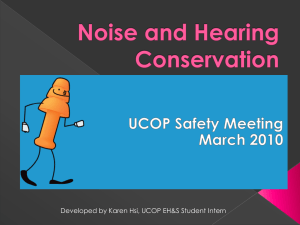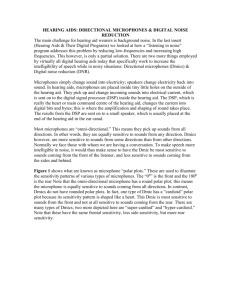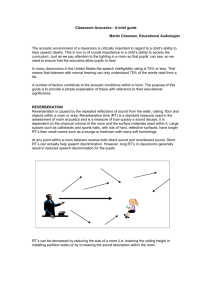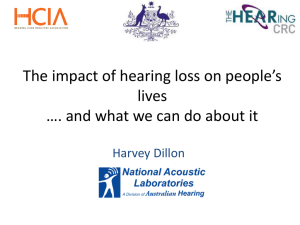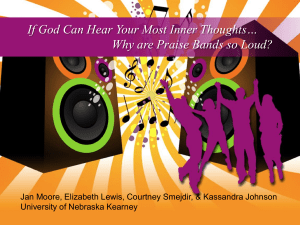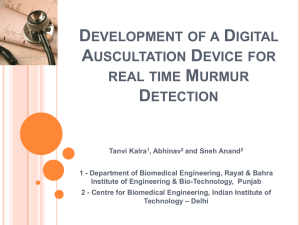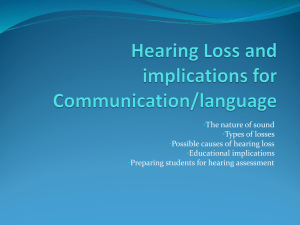Week 7 - Truth Recordings
advertisement
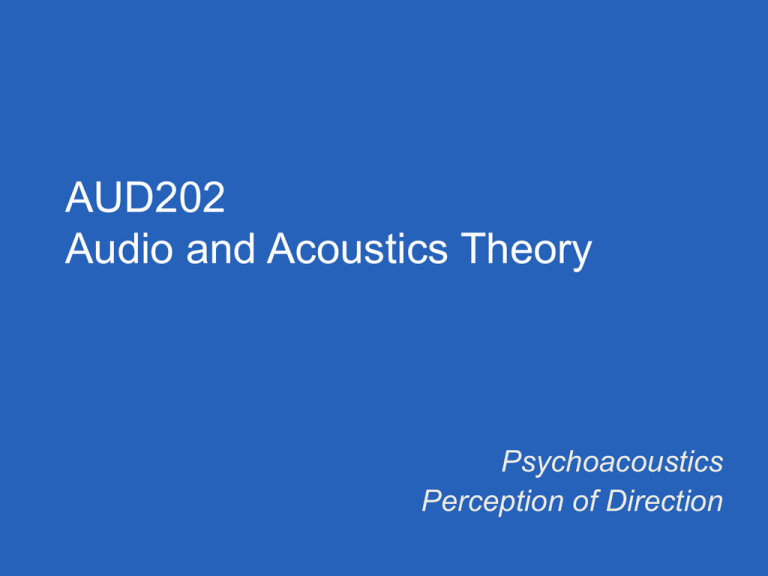
AUD202 Audio and Acoustics Theory Psychoacoustics Perception of Direction Last Week > The Decibel Upcoming Events 11 Days - NIHL Report 32 Days - Sound Observations Report 42 Days - Exam Psychoacoustics The study of the perception of sound - How we hear - How we can separate different sounds - Our psychological responses - The physiological impact of sound/music Areas in Psychoacoustics • • • • • • • Development of audio codecs Perception of sound content Auditory Illusions Psychological effects of music therapy Studies of what sounds/music people like Localisation Speech recognition Some Psychoacoustic Effects Binaural Beats Masking Effect Hass Effect (also called Precedence effect) Binaural Beats The Cocktail Party Effect Missing Fundamental McGurk Effect Binaural Beats is the result of playing two tones of closely spaced frequency in opposite ears through headphones. The Cocktail Party Effect The ability to focus listening on a particular sound whilst filtering out unwanted sounds. Masking: Weaker sounds can become inaudible in the presence of louder sounds. The principle behind ‘perceptual encoding’ and mp3s. Psychoacoustic Effects Missing Fundamental: If we play a harmonic series of pitches such as 2×f, 3×f, 4×f etc it can give the impression that the fundamental pitch is present. The Haas Effect The Haas Effect (Precedence Effect) We localise sound based on the direction of the first arriving sound. Additionally we fuse the direction of subsequent reflections with that of the original sound despite the real direction of the reflected sound. The Illusion of Stereo With one speaker, we only hear the direction of one sound point. With two speakers we hear a soundstage? What are the limitations of surround sound systems? Perception of Direction Can we localise the direction of a sound’s origin with only one ear? Perception of Direction Using two ears to localise a sound source is called spatial or binaural localisation. This is based on three acoustic cues received by the ears: 1.Interaural intensity differences 2.Interaural time differences 3.The effects of the pinnae Wavelength and Head Size • Waves with a length less than the diameter of the human head (17cm) will not diffract around the head, so • Waves with a length longer than 17cm will diffract around the head allowing for localisation using time differences. Sound Localisation Interaural intensity differences (IID) for perceiving direction of high frequencies Interaural time differences (ITD) for perceiving direction of low frequencies Sound Localisation The pinna creates a delay used to determine ‘front to back’ and vertical panning due to the shape of the pinna. Psychoacoustic Effects Scale Illusion Phantom Melodies Shepherds Ascending Tones Falling Bells Quickening Beat Virtual Barbershop Matchbox Rattle McGurk Effect Phantom Words Doppler Effect A moving sound source creates a pitch change to a stationary listener. As the sound comes towards the listener, the pitch is higher. As the sound goes away, the pitch is lower. Doppler Effect A moving sound source creates a pitch change to a stationary listener. As the sound comes towards the listener, the pitch is higher. As the sound goes away, the pitch is lower. NOISE INDUCED HEARING LOSS Noise Induced Hearing Loss • Report due next Sunday (the 20th of April) • 1000 words • Remember: Title page, 12pt font, Arial or Times, 1.5x line spacing, Reference & Bibliography sections, Harvard Referencing. • Use rubrics (on Moodle) to double check report criteria. Noise Induced Hearing Loss • NIHL is acquired hearing loss caused by exposure to excessive noise. • Exposure to loud sound can cause the hair cells in our inner ear to be damaged, resulting in noiseinduced hearing loss. • Noise exposure charts can help to determine safe noise levels Noise Damage Indicators If sounds seem muffled or softer after noise exposure, your are likely experiencing a temporary threshold shift. If you are repeatedly exposed to excess noise without protection, the shift can become permanent and untreatable. OH&S Principles • Understand the noise level exposure time chart and recognise when you are damaging your hearing • Limit your exposure to loud noise, otherwise protect your ears with hearing protection • Use your knowledge to help protect others, e.g. young children, musicians etc



